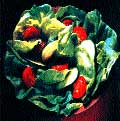The forms of alternative medicine
 Mind-body intervention
Mind-body intervention
psychotherapy: includes combining medication with discussion, listening to the patient or using more active behavioural and emotive psychological methods; can hasten recovery in somatic illnesses.
support groups: group therapy and counselling combined with diet and exercise can reverse diseases like angina pectoris.
meditation: increases longevity and quality of life, reduces anxiety, blood pressure and serum cholesterol level.
imagery: a form of meditation; encourages changes in attitude, behaviour, or physiological reactions; used in cancer treatment.
hypnosis: used in treatment of congenital ichthyosis (a genetic skin disorder), phobias and addictions; helps in reducing bleeding in haemophiliacs, stabilising blood sugar in diabetics etc.
biofeedback: patients use monitoring instruments to recieve physiological information and adjust their thinking and other bodily processes to control their blood pressures, temperatures, gastrointestinal functioning and brain wave activity accordingly.
yoga: used to reduce anxiety, lower blood pressure and cure arthritis.
dance therapy: for dealing with problems caused by low self-esteem such as depression, suicidal ideas, etc, in relieving bodily tension and chronic pain and enhancing respiratory and circulatory functions.
music therapy: analgesic, relaxant and anxiety reducer for infants and children; complementary treatment for burn victims and cancer, cerebral palsy, stroke, brain injury or Parkinson's disease patients.
art therapy: to reconcile emotional conflicts and foster self-awareness; valuable for children who cannot speak out.
prayer and mental healing: affects physiological functions when the target (bacteria, viruses etc) is unaware that such an effort is being made.
Bioelectromagnetics
Studies how human beings react to electromagnetic (EM) fields; non-ionising and non-thermal EM fields are being used for bone repair, nerve stimulation, wound healing, treatment of osteoarthritis, electroacupuncture, tissue regeneration and immune system stimulation.
Alternative systems
traditional Oriental medicine: acupuncture, acupressure, herbal medicine, qiqong, and Oriental massage; each emphasises diagnosing disturbances of qi or vital energy; uses being studied in chronic hepatitis, rheumatoid arthritis, hypertension, AIDS and certain cancers.
acupuncture: involves stimulating specific anatomic points in the body which have electrical properties; this alters chemical neurotransmitters in the body; for treating osteoarthritis, chemotherapy-induced nausea, asthma, back pain, painful menstrual cycles, bladder instabilities and migraine headaches.
ayurveda
homoeopathy
anthroposophically extended medicine: seeks to match the thermodynamic force in plants, animals and minerals with disease processes in humans.
naturopathy: integrates traditional natural therapeutics with modern scientific and medical diagnostics; research has focussed on women's health; effective as alternatives to estrogen replacement therapy.
environmental medicine
community-based healthcare practices: often part of a community's cultural traditions; practitioners emphasise naturalistic, personalistic and energetic models.
Manual healing methods
osteopathic medicine: used in internal medicine and obstetrics for musculoskeletal and non-musculoskeletal problems.
chiropractic medicine: investigates the relationship between structure (of the spine) and function (of the nervous system) to treat structural dysfunctions that affect the nervous system.
massage therapy: includes Swedish massage, deep-tissue massage, sports management, neuromuscular massage and manual lymph drainage.
biofield therapeutics: based on two underlying rationales
Related Content
- Kenya plans new regulatory framework for alternative medicine
- Budget 2013-2014: speech of P. Chidambaram, Minister of Finance
- Legislative regulation of traditional medicinal knowledge in Eritrea vis--vis Eritrea's commitments under the Convention
- Silver bullet
- Innovation and technology transfer to address climate change
- Clay has curative properties
